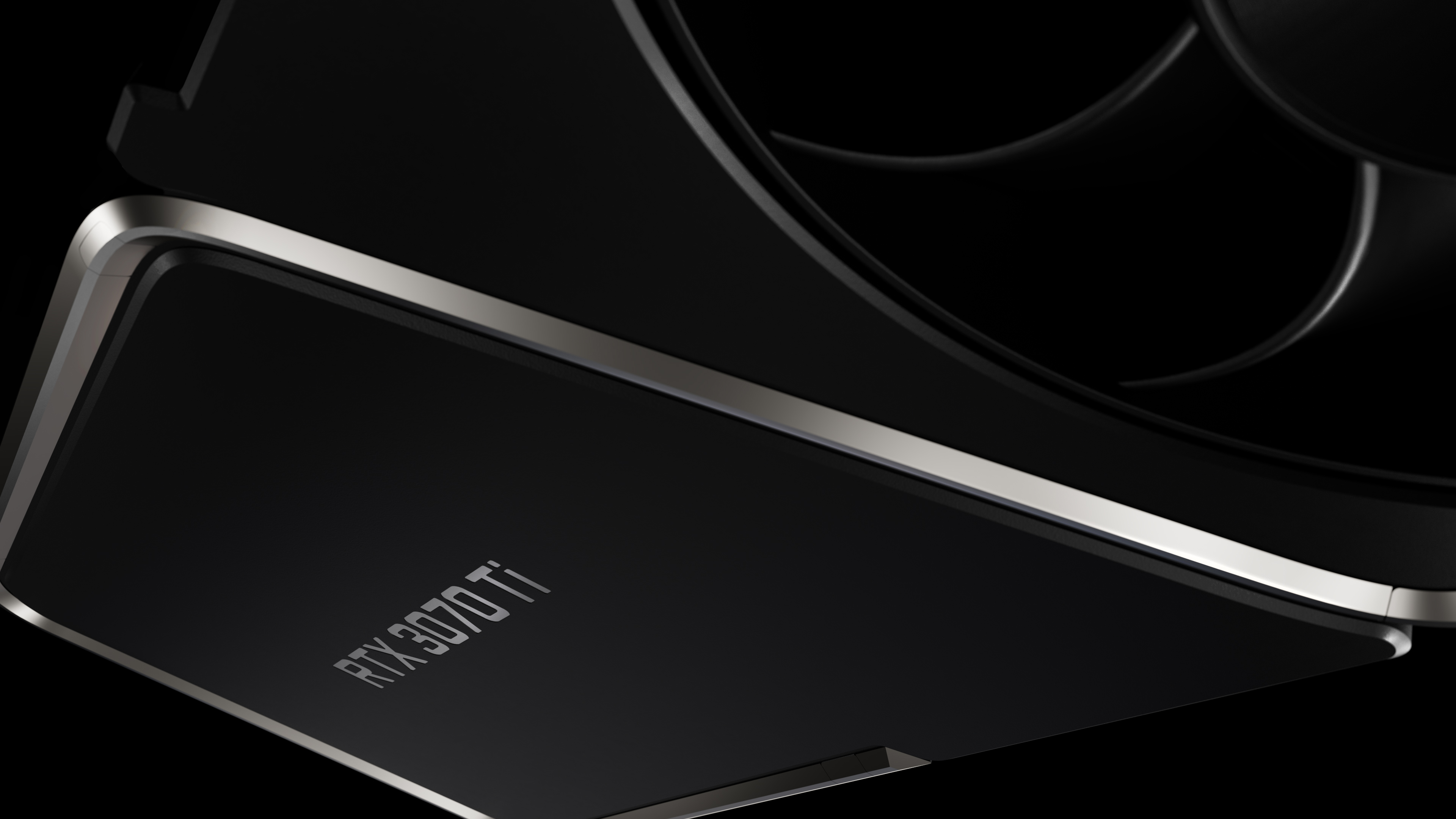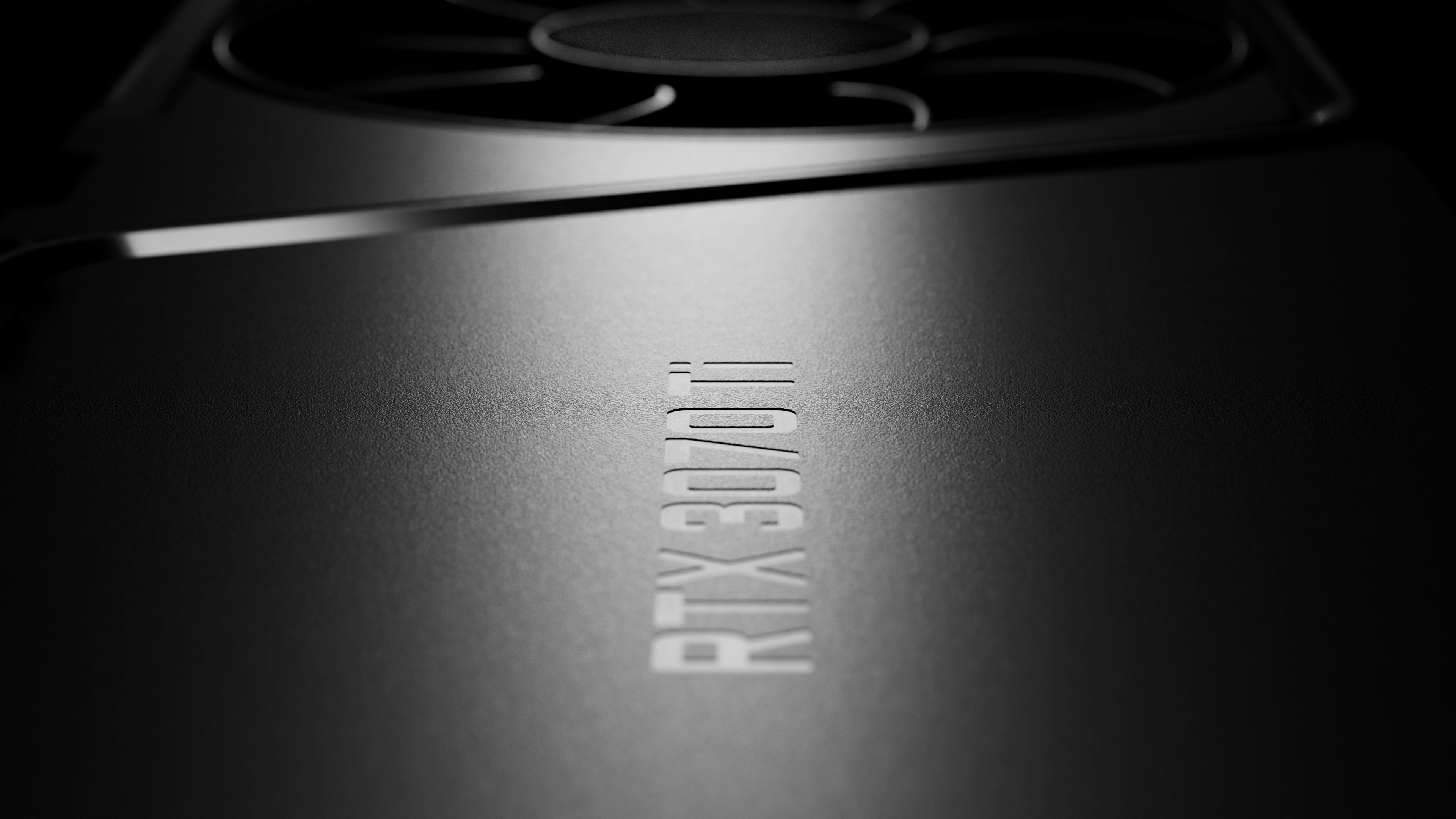Nvidia Reveals GeForce RTX 3080 Ti: A 3090 With Half the VRAM
After months of rumors and speculation, Nvidia has finally revealed the GeForce RTX 3080 Ti, the long-awaited heir to the GeForce RTX 2080 Ti. Forget the earlier 20GB VRAM rumors; the 3080 Ti is basically an RTX 3090 with half the VRAM. With specifications and performance so close to the GeForce RTX 3090, the new Ampere offering will have no problems competing for a spot with the best graphics cards on the market. Here's the quick overview:
| Graphics Card | RTX 3090 | RTX 3080 Ti | RTX 3080 | RTX 2080 Ti |
|---|---|---|---|---|
| Architecture | GA102 | GA102 | GA102 | TU102 |
| Process Technology | Samsung 8N | Samsung 8N | Samsung 8N | TSMC 12FFN |
| Transistors (Billion) | 28.3 | 28.3 | 28.3 | 18.6 |
| Die size (mm^2) | 628.4 | 628.4 | 628.4 | 754 |
| SMs / CUs | 82 | 80 | 68 | 68 |
| GPU Cores | 10,496 | 10,240 | 8,704 | 4,352 |
| Tensor Cores | 328 | 320 | 272 | 544 |
| RT Cores | 82 | 80 | 68 | 68 |
| Base Clock (MHz) | 1,395 | 1,370 | 1,440 | 1,515 |
| Boost Clock (MHz) | 1,695 | 1,665 | 1,710 | 1,545 |
| VRAM Speed (Gbps) | 19.5 | 19 | 19 | 14 |
| VRAM (GB) | 24 | 12 | 10 | 11 |
| VRAM Bus Width | 384 | 384 | 320 | 352 |
| ROPs | 112 | 112 | 96 | 88 |
| TMUs | 328 | 320 | 272 | 272 |
| TFLOPS FP32 (Boost) | 35.6 | 34.1 | 29.8 | 13.4 |
| TFLOPS FP16 (Tensor) | 142 (285) | 136 (273) | 119 (238) | 108 |
| RT TFLOPS | 69.5 | 66.6 | 58.1 | 52.5 |
| Bandwidth (GBps) | 936 | 912 | 760 | 616 |
| TDP (watts) | 350 | 350 | 320 | 260 |
| Launch Date | Sep 2020 | Jun 2021 | Sep 2020 | Sep 2018 |
| Launch Price | $1,499 | $1,199 | $699 | $1,199 |
Armed with 80 out of a potential 84 Streaming Multiprocessors (SMs) from the GA102 GPU, the GeForce RTX 3080 Ti offers consumers 10,240 CUDA cores with a 1,665 MHz boost clock alongside 320 third-generation Tensor Cores for AI and 80 second-generation RT cores for ray tracing workloads. With the CUDA cores alone, it’s easy to see why Nvidia is boasting that the GeForce RTX 3080 Ti delivers up to 1.5 times higher performance than the GeForce RTX 2080 Ti. For those of you who love numbers, the GeForce RTX 3080 Ti pumps out 143%, 139% and 56% higher shader TFLOPs, Tensor TFLOPs and RT TFLOPs, respectively. It also has 48% more memory bandwidth.
We can also look at the more recent Ampere GPUs for comparison. The GeForce RTX 3080 Ti is only a hair behind the GeForce RTX 3090 in most areas, with the biggest difference being VRAM capacity. 3080 Ti wields 12GB of GDDR6X memory at 19 Gbps, on a 384-bit memory interface, meaning the GeForce RTX 3080 Ti lands with a maximum theoretical memory bandwidth up to 912 GBps. On paper, it's only about 3–4% behind the 3090, except for having half the memory. Alternatively, the 3080 Ti has 14% more compute and 20% more bandwidth than the vanilla RTX 3080.
For better or worse, the 3080 Ti takes after the GeForce RTX 3080 in terms of design — if not for the "Ti'' branding, we'd swear that we're looking at a GeForce RTX 3080. The GeForce RTX 3080's dual-slot cooling system is less robust than the GeForce RTX 3090’s triple-slot cooler, though really it's the GDDR6X memory that gives us the most cause for concern. The 3090 and 3080 Founders Edition cards could run very hot on the memory, and the same goes for a lot of the third party designs. Adding two more GDDR6X modules isn't going to improve the situation with the 3080 Ti.
The GeForce RTX 3080 Ti is also rated with the same 350W TDP as the GeForce RTX 3090, compared to the GeForce RTX 3080's 320W TDP, so we're looking at 30W overhead. Common sense would tell us that the cooling fans will have to work a bit harder, which may increase the operating noise level. There is evidence that replacing the stock thermal pads on the GeForce RTX 3080 and GeForce RTX 3090 helps better cool the memory chips. So, the big question is whether Nvidia substituted the thermal pads on the Ti. We suspect not, but let's hope Nvidia proves otherwise.



The GeForce RTX 3080 Ti's other attributes align with those of the non-Ti. The Founders Edition is still happily rocking Nvidia's 12-pin PCIe power connector. Display outputs still come down to one HDMI 2.1 port and three DisplayPort 1.4a outputs. Nvidia is set to launch the RTX 3080 Ti on June 3, with an official launch price of $1,199.
Considering the rest of the graphics card market right now, not to mention what we've seen of previous Ampere launches, that price is likely to be meaningless throughout 2021 and into 2022. The RTX 3080 continues to immediately sell out and generally goes for over $2,000 on eBay, and the RTX 3090 lands closer to the $3,000 range right now. Unless Nvidia can produce a lot more GPUs and cards, shortages and price gouging are likely to continue.
Nvidia GeForce RTX 3070 Ti
Besides the RTX 3080 Ti, Nvidia also officially announced the GeForce RTX 3070 Ti. The graphics card presumably utilizes GA104 silicon, which is the same die inside the GeForce RTX 3070. The Ti comes with two additional SMs, which gives the GeForce RTX 3070 Ti 6,144 CUDA cores, 192 Tensor cores and 96 RT cores.
Nvidia clocks the GeForce RTX 3070 Ti higher than both the GeForce RTX 3070 and GeForce RTX 3080. It features a 1,575 MHz base clock and 1,770 MHz boost clock. With these clock speeds, the GeForce RTX 3070 Ti delivers a FP32 performance up to 21.75 TFLOPs. The potentially bigger change is in the memory, as the 3070 Ti will use GDDR6X instead of GDDR6 VRAM.
The GeForce RTX 3070 Ti ends up being a moderately faster variant of the existing GeForce RTX 3070. In comparison to the GeForce RTX 2070 Super, however, Nvidia is claiming a performance uplift up to 1.5X.
| Graphics Card | RTX 3080 | RTX 3070 Ti | RTX 3070 | RTX 2070 Super |
|---|---|---|---|---|
| Architecture | GA102 | GA104 | GA104 | TU104 |
| Process Technology | Samsung 8N | Samsung 8N | Samsung 8N | TSMC 12FFN |
| Transistors (Billion) | 28.3 | 17.4 | 17.4 | 13.6 |
| Die size (mm^2) | 628.4 | 392.5 | 392.5 | 545 |
| SMs / CUs | 68 | 48 | 46 | 40 |
| GPU Cores | 8,704 | 6,144 | 5,888 | 2,560 |
| Tensor Cores | 272 | 192 | 184 | 320 |
| RT Cores | 68 | 48 | 46 | 40 |
| Base Clock (MHz) | 1,440 | 1,575 | 1,500 | 1,605 |
| Boost Clock (MHz) | 1,710 | 1,770 | 1,725 | 1,770 |
| VRAM Speed (Gbps) | 19 | 19 | 14 | 14 |
| VRAM (GB) | 10 | 8 | 8 | 8 |
| VRAM Bus Width | 320 | 256 | 256 | 256 |
| ROPs | 96 | 96 | 96 | 64 |
| TMUs | 272 | 192 | 184 | 160 |
| TFLOPS FP32 (Boost) | 29.8 | 21.75 | 20.3 | 9.1 |
| TFLOPS FP16 (Tensor) | 119 (238) | 87 (174) | 81 (163) | 72 |
| RT TFLOPS | 58.1 | 42 | 39.7 | 27.3 |
| Bandwidth (GBps) | 760 | 608 | 448 | 448 |
| TDP (watts) | 320 | 290 | 220 | 215 |
| Launch Date | Sep 2020 | June 2021 | Oct 2020 | Jul 2019 |
| Launch Price | $699 | $599 | $499 | $499 |
Nvidia only equipped the GeForce RTX 3070 Ti with 8GB of GDDR6X memory at 19 Gbps. This might seem like a disappointment for many consumers, who were expecting at least 10GB, like the GeForce RTX 3080. The GeForce RTX 3070 Ti also has a narrower memory bus, meaning it's only good for 608 GBps of memory bandwidth.
Get Tom's Hardware's best news and in-depth reviews, straight to your inbox.
It remains to be seen whether the GeForce RTX 3070 Ti can provide a sensible performance upgrade over the GeForce RTX 3070. The GeForce RTX 3070 Ti variant rocks a 290W TDP, a significant 31.8% increase over the non-Ti model. As usual, you'll find the Founders Edition with the 12-pin PCIe power connector. Obviously, Nvidia's partners will opt for a dual 8-pin PCIe power connector setup instead.




The GeForce RTX 3070 Ti gives Nvidia a chance to realign prices with the current market by bumping the price up to $599. It's $100 cheaper than the GeForce RTX 3080, but then performance will also be lower than the 3080.
We likely won't see Nvidia's new Ampere offerings at their respective MSRP at retail in sufficient quantities, but unlike graphics cards, dreams are free. We're looking forward to testing and reviewing both the GeForce RTX 3080 Ti and GeForce RTX 3070 Ti in the coming weeks.

Zhiye Liu is a news editor, memory reviewer, and SSD tester at Tom’s Hardware. Although he loves everything that’s hardware, he has a soft spot for CPUs, GPUs, and RAM.

